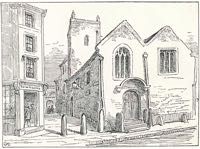
St George's Church, South Street
Page updated 16th October 2015
St George's Church, South Street is one of the lost and forgotten churches of the city as the site has completely disappeared following the rebuilding after the war.
The date of the founding is unknown, although excavations after the war revealed Saxon stonework (9th or 10th Century) surviving from the church. Built of course Heavitree sandstone, with a single aisle and chapel—a south aisle was added in the 15th Century. Internally the church was small with a 33 ft (10 metres) long and 15 ft (4.5 meters) wide nave, and a tower at the west end, bounding George Street.The tower was constructed in the 15th century and housed three bells which were recast as five bells in 1740.
The church appears in a Deed of Assignment made by Peter de Palerna, sometime between 1200 and 1216. He left money to 28 of Exeter's churches and chapels. St George's received one penny, to be paid annually on the 4 February. It was recorded that it became a parish church in 1222. Like St John's Church in Fore Street it was held by the Priory of Plympton whose town residence was on the site of the Black Lion's Inn, which was almost opposite the Church of the Sacred Heart, also in South Street. The church passed to the Crown on 1 March 1539, in the Reformation.
In 1658, in common with many other churches in the city, an ordinance of Parliament demanded that St George's be sold for use as a burying place or school, which it duly was, for the sum of a £100. The restoration of the monarchy two years later saw the church pass back to the people. Up until 1814, St George's was held in commendam or by a patron, when in that year it was given a rectory.
Exeter has always been a city of road widening, and the broadening of South Street was on the agenda in the nineteenth century. St George's Church was particularly obstructive, as it projected out further into the street than its neighbours, which had already had their frontage removed to widen the street. The Revd. John Clindon Cleeve who held the living, from 1818, was approached by the Improvement Commission, as early as 1835, for permission to demolish the front of the church. Cleeve refused unless the Commission would grant, for every lost foot at the front, an extra two feet at the rear. Moreover, Cleeve stated that the church would not be touched while he still lived. Deadlock ensued until 1842 when the good reverend died, and in 1843 the church was demolished. The site was made into an iron fenced garden with sections of the north and west walls incorporated into adjacent properties. A path in the garden was lined with gravestones, one of which had the epitaph:
Here lyeth the body of
Thomas
Gist of this parish
Fuller who departed
this life the 20th January
1671.
T homas could not believe, but when
he spyed
H is Saviour's
wounds, My Lord and God he cry'd !
O h Faith wer't not for thee heavens endless joys
M ight be esteemed no more than
childish toys,
A nd he whose
body here in hope doth rest
S hould not in heaven be a welcome guest.
There was a plan proposed in 1844 to install a memorial to Richard Hooker, in the form of a Tudor ornamental cross, in the garden, but it did not progress. It would not be until 1907 that a statue to Hooker was unveiled, in Cathedral Close.
The parish of St George was merged with St John's in 1843. Many of the monuments were transferred into St John's along with the five bells, that would ring again over Fore Street. The register for the church dates from 1682.
This part of South Street was reduced to rubble in the May 1942 bombing. After the war, archaeological excavations revealed the remains of two boundary walls dating from Saxon times. There were constructed largely from rubble, some of which was Roman, including pieces of Roman roof tiles and a section of 9 in (22 cm) in diameter, limestone column and a piece of moulded capital. The excavations indicated that despite the inclusion of Roman rubble, the church probably dates from the time of King Athelstan (925–940).
The opportunity was taken to preserve part of one of the remains, and a section of doorway and wall was carefully removed and placed in the small garden of the ruins of the Hall of the Vicars Choral, opposite, where it can be seen today.
Sources: Devon and Cornwall Notes and Queries Volume 2 (1902 to 1903) and Volume 3 part 5 (January 1905). Roman Exeter, Excavation in the War Damaged Areas 1945-1947 by Aileen Fox and the Flying Post.
│ Top of Page │



